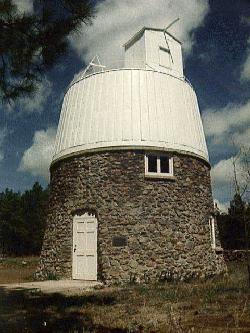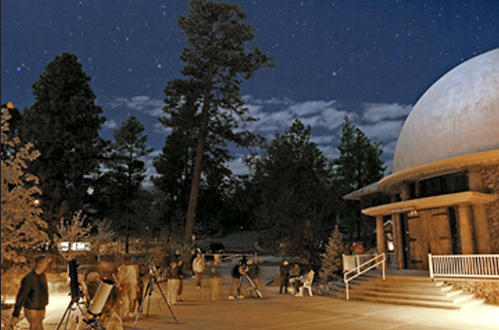Lowell Observatory
The Lowell Observatory in Flagstaff, Arizona, USA, was founded by Percival Lowell in 1894 to investigate the planet Mars and the 1877-1879 observed by Giovanni Schiaparelli canals of Mars ( " Canali " ) in more detail. For about 90 years, it also serves other astronomical research.
Lowell was a wealthy lover astronomer and held the Canali ( incorrectly as " Canals " translated) for engineering structures of intelligent beings to irrigate the desiccating Mars. The color changes he noted in his observations, he led back to changes in the vegetation. This idea was from Mars some researchers still to planning and arrival of the spacecraft Following ( Mariner 4 in 1965 ).
The observatory was planned by the brothers Edward and William Henry Pickering - on dry wasteland in 2210 m height. It was equipped from the beginning with the most modern instruments and each had, for example, 1910, 1.1 m, the world's third largest reflecting telescope.
Flagstaff is located in central Arizona, about 120 km south of the Grand Canyon, between Mount Humphreys ( 3,854 m) and Sunset Crater ( eruption 950 years ago, more than 2,000 square kilometers of ash and lava). The Geological Museum also describes the San Francisco Peaks - the volcanoes north of Flagstaff for climbing and winter sports - and the world famous Meteor Crater, but still has its special museum.
1912 Vesto Slipher began in Flagstaff take spectra of spiral nebulae. Despite strong light instruments exposures over several nights were needed to - except for the Andromeda nebula. In this, the spectral lines were ( instead of red ) shifted into the blue, what Slipher said about the motion of the Milky Way. One of his students was Edwin Hubble, the general redshift indicated later by expansion of the cosmos.
Pluto was discovered in 1930 after decades of preparatory work in Flagstaff. For several years, the observatory is used to search for asteroids. In the project " Near Earth Object Survey" ( LONEOS ) for an automatic telescope was developed.
In Flagstaff is also the USGS Center for Planetary Geology. Here Eugene Shoemaker was largely responsible for the geological studies for the preparation of the moon landings. In 1969 he returned as a professor of geology back to the Department of Geological and Planetary Sciences in Pasadena.
Since 1959, the Lowell Observatory operates a location in Coconino County outpost called Anderson Mesa Station (IAU code 688 ).
The Lowell Observatory was recognized on 21 December 1965 as a National Historic Landmark.
Since 2012 is the largest telescope of the Lowell Observatory, the Discovery Channel Telescope in operation.










